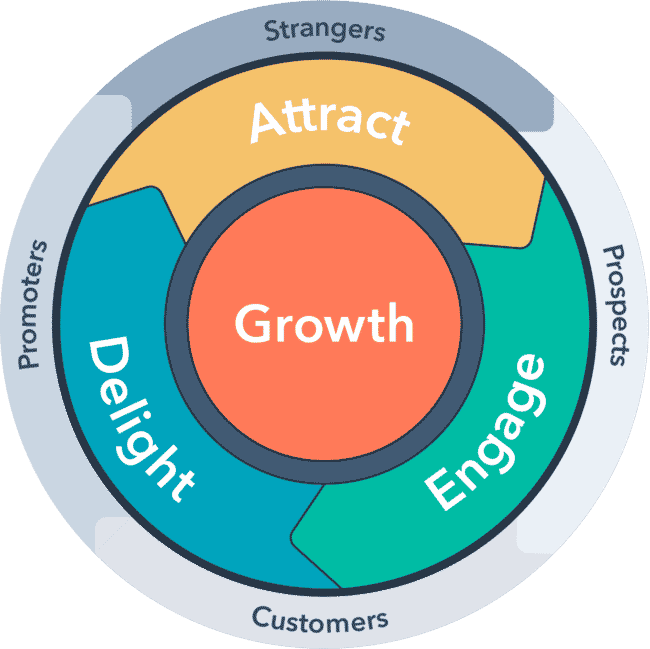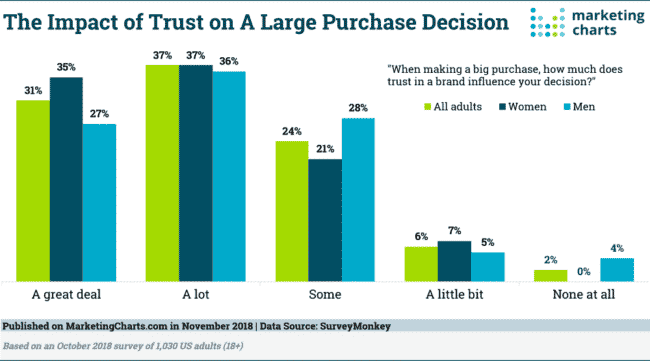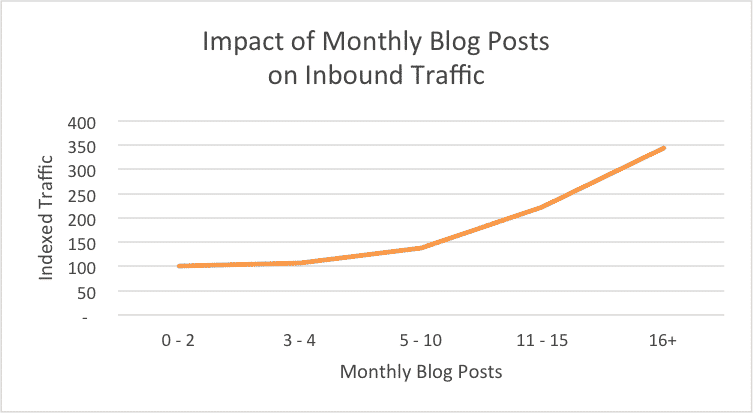
Content marketing is a digital strategy that helps you connect to customers, directly and organically.
Instead of bombarding potential customers with repetitive messaging full of sales speak, content marketing is a modern-day rebuke to these traditional marketing strategies. And one that allows you, as a business owner or marketer, to engage with and make a genuine connection with your audience and customers. Your people.
The genuine part is key. The goal of content marketing is to turn curious prospects into diligent promoters. You won’t achieve this with one video or blog post, in most cases, but it is a cyclical process that can bring big results.
And beyond the general annoyance of traditional, wide-cast marketing strategies like television commercials, magazine ads, and billboards, the more modern concept of being “followed around the internet” just flat out creeps people out.
Table of Contents
The Sweet Spot Of Content Marketing
There’s a marketing sweet spot where you can still advertise your products with highly-targeted content that educates, entertains, and – most importantly – builds trust with your customers.
Where the aforementioned traditional marketing methods, paid advertisements, 15-second YouTube ads, and digital retargeting still all hold value, content marketing is the antithesis of these outbound marketing tactics.
Content marketing is not in-your-face hard selling and it is not interrupting a video to push a product.
These are two of many “outbound” digital strategies. “Inbound” marketing aims to build trust by building meaningful, lasting relationships with consumers, prospects, and customers.
Why? Because trust matters in the business world, maybe now more than ever. Trust between a business and customer is not just about protecting data or delivering high-quality products or services.
Trust is also built through educational, useful, and interesting content marketing that establishes you as a subject matter expert in your industry.
Inbound marketing and content marketing are interchangeable terms in many ways.
The goal of both, as HubSpot’s Flywheel depicts above, is to:
- Attract – Draw in the right people with valuable content and conversations that establish you as a trusted advisor with whom they want to engage.
- Engage – Present insights and solutions that align with their pain points and goals so they are more likely to buy from you.
- Delight – Provide help and support to empower your customers to find success with their purchase(s).
Safe to assume that people trust the content that solves their problems, more than the content that aggressively annoys them. Much better to delight than to pester, right?
To that end, it is important to be mindful of just how many ads we all actually see each day…
Today, the average person sees about 10,000 ads per day – and less than a quarter are relevant to their interests.
We are inundated with thousands of ads we don’t care about – every single day.
Content marketing is the caveat to this oversaturation and overstimulation.
Content Marketing Connects You To Customers
The truth is that people don’t hate all marketing and all advertisements.
People strongly dislike creepy, redundant, invasive ads.
Content marketing is a novel answer to this traditional marketing framework of hard sells and repetition. One that lets you connect with your customer in a way they actually enjoy or find useful.
Daniel Kahneman, whom many consider the Father of Behavioral Science, perfectly explains the traditional marketing ideology (and why we all mostly loathe the idea altogether):
“A reliable way to make people believe in falsehoods is frequent repetition because familiarity is not easily distinguished from truth. Authoritarian institutions and marketers have always known this fact.”
Bashing people over the head with the same message over and over again, it seems, may actually turn them off your product. Where it worked in the past and still does to some degree today, people also saw far fewer ads in the past.
We are ad-exhausted and marketers are taking note.
Think of content marketing as the opposite of “if it isn’t broken, don’t fix it” – but as it relates to digital strategy.
So… What Is Content Marketing, Exactly?
This may seem self-explanatory, but give it a beat to think over.
Content marketing, as discussed, can be many things. It is the process of creating something of value that meets your customer’s needs and attracts them to your business.
Content aids them in understanding your brand USPs and what sets you apart from the competition.
Through effective content, you build a positive brand image that can turn a ‘stranger’ into a ‘customer. Maybe not on the first touchpoint, but through consistently delivering quality content that provides value to them.
Beyond all that, content marketing encourages them to send other potential customers to your business.
This is the ‘promoters’ section of the flywheel. While takes a lot to turn strangers into customers, it takes more to turn a stranger into a promoter.
But it’s worth the effort.
That’s why 83% of marketers focus on word-of-mouth marketing to increase brand awareness.
Let’s Define ‘Content’
Content is not blog posts.
It isn’t running surveys.
It’s not videos.
It’s not infographics.
Those are mediums.
Content is the message. That is absolutely imperative to understand to succeed in content marketing.
It’s the story and the why, as Simon Sinek so aptly notes below.
It’s the idea you communicate, and those ideas can be communicated in a myriad of ways.
Few, if any, businesses have applied this concept as effectively as Apple.
As with Apple, some methods are going to work better than others to spread your ‘why’.
The point is that you have a variety of mediums through which to communicate it and then a variety of ways to promote that to people who seek out that information.
Now, there are two parts to this equation:
Content And Marketing
First, there is the content side. You need a story, message, the ‘why’ to communicate at its heart.
You put that information together and then you settle on the medium to use to communicate that message. The medium here is a blog post. To convey this information, a blog post felt like the most effective medium. Plus, this would almost definitely make for a pretty boring video. The medium is important.
Then, comes the marketing side.
While content marketing is in large part an inbound marketing strategy, you still need to get the message out. You’re probably coming to this post because of the marketing done to promote it; whether that’s through organic search, search engines, an email list, an ad, or some other channel. The channel is also important.
TL;DR: Content without marketing is not content marketing.
How Content Helps Builds Trust
A national car dealership delivers short, funny video clips on Tik-Tok to help first-time car buyers understand the intricacies of financing their first vehicle. One video gets 3.2m shares. They see a 25% rise in website traffic.
A new barber shop supplier puts out a blog post specifically for newly opened shops with top suppliers around the country, tips for sourcing, and organically plugs their own products in the post. This post is shared 10,000 times across Facebook Groups for barbershops. The shop sees a 15% surge in requests for quotes.
These are both entirely hypothetical yet entirely realistic examples of effective content marketing.
As a real-life example, a recent study found that 92% of respondents from the US prefer to buy medical care from an established brand than a new startup brand (8%). Understandably, people put their trust in products that have delivered a good product with a meaningful story over a period of time – especially when it comes to their health.
[Here are 9 more examples of exceptional content marketing at work.]
You need to earn trust because trust leads to sales. Your brand needs to attract, engage, and delight customers with a message (content) that fulfills a need, a desire to learn, or can just flat-out entertain them.
And again, this needs to happen over a sustained period of time.
Content marketing is the way you deliver that material. Done right, you build rapport and trust with your customers.
For decades, both offline and digital businesses have used content and storytelling to build something around a message or story that their customers love.
A message that attracts as many customers as they could ever need. One that helped them build their business in order to scale it to its full potential.
Kindra Hall, a WSJ best-selling author, discusses how specific messaging to customers who are seeking that information contributed to this billion-dollar story.
To be clear, there are other ways to build a business, and not every business will use content marketing. In today’s climate, content marketing seems like a no-brainer but it does require time and consistency. Most businesses, especially new ones, tend to be running low on both.
However, many have built successful businesses using only paid channels. Or by promoting products on Pinterest, or a myriad of other ways.
Those ways absolutely work for the right businesses. They could likely lower their ROI by combining a content marketing strategy into their paid channel funnel but it does require a time commitment many aren’t able to manage.
At the end of the day, content marketing works. But you have to look at it the right way, with the right expectations.
Expectations for Content Marketing
Now, let’s talk about setting your expectations for how content marketing works.
Beyond that, when (and how) you’ll see it start to help grow your business.
Let’s start with this: content marketing is an investment and not a transaction. If you look at it only as a transaction (X dollars generates Y returns) then you’ll be disappointed with the lack of immediate results.
Typically, this is where we hear “content marketing doesn’t work for me”.
That can usually mean “we tried it for a week and have no idea what we’re doing and it feels like a total waste of time and we have no time to waste”.
The thing is, content marketing works – for everyone.
How well it works, as with anything, depends on the time you are willing to commit to doing it the right way. This can differ depending on your business and your goals.
You can’t just take one person’s process or strategy and apply it 100% to your business and expect it to just work.
You need to think about it as it applies to your business, your customers, and your specific ‘why’.
Measure, Measure, And Then Some More
Most people who drop the “doesn’t work for me” don’t actually know if content marketing is or is not working.
Why? Because they have no idea how to measure the success of their efforts.
This is a completely different conversation that can be solved with the right set of tools.
Long story short, they started content marketing without knowing what “success” would mean for them. Because they don’t know what success would even look like, they will find it exceedingly hard to measure.
Just like SEO, content marketing takes time. You really can’t separate the two, as content marketing can absolutely drive more SEO success – and vice versa (via ranking for terms, earning or building links back to your site, and more). Connecting these two strategies is part of what makes content marketing a challenge.
But it takes time. Check out these graphs where they invested in content and over time they saw success:


Next, let’s talk about a content marketing process that you can use to get yourself started.
How Content Marketing Works For Your Business
Content marketing is a fluid process.
Just like anything else, it goes through stages – including:
- Strategy
- Creation of content
- Promotion
- Measurement
- Realignment of strategy
- Creation
- Promotion
- Measurement
- Go back to step 5
Producing industry-leading content that grows your business involves:
- Research topics that your customers are interested in, or stories that you think they will find interesting.
- Gather the information in order to tell a story that sticks.
- Decide on the medium through which to communicate that information.
- Create a list or audience that will find the content helpful or useful.
- Create the actual piece of content.
- Promote it.
That is a lot of work. Let’s talk about each step.
Defining Your Strategy
Businesses live and die by the effectiveness of their strategy and the research that went into it ahead of time.
Please remember, that everything – marketing or business – starts with strategy.
You’re looking at:
- Who are your potential customers and what do they need from your marketing?
- Who are your competitors and what are they doing to reach the same customers?
- What stories or ideas are not being communicated by your competitors that you can communicate?
For instance, maybe you’re in a B2B space and your competitors look very… B2B.
They’re boring, serious, and stoic. They have no personality and little interest in creating one.
That lack of interest is how you get your foot in the door.
Yes, B2B can build a brand that is accessible and produce content that people love and want to spread. Remember our barbershop example from above?
But, how do you put together that strategy?
Start with the research and look at things like:
- What terms are your competitors ranking for in the search engines, how profitable do you think these are, and how have they ranked for them? (Use tools like AHREFS or SEMrush.)
- What does their content process seem to be, how often are they putting it out, and how are they promoting it? (For this, download their content from RSS and use tools like SimilarWeb to figure out their promotion strategy.)
- What are the new ideas that your competitors are not doing? Maybe it’s a medium (video). Maybe their design is boring and you have a fantastic designer, which will set you apart. Differentiate yourself!
Once you’ve identified what your competitors are doing and therefore what your own competitive advantage could be, you now know where to start with your hypotheses.
The Creation Cadence
Your creation process is heavily dependent on your team and the resources (money and time) that you have at your disposal.
If you have a part-time content person and no designer, you can’t produce industry-leading content at a massive scale. This is getting easier to do with social channels like Instagram Reels and Tik-Tok, but will remain a challenge.
Cadence matters. Pick a publishing timeline that you can commit to for the next two months. Here is one example of the impact of frequent blogging on inbound website traffic.
Two months is long enough to know if it is sustainable and also to see signs of initial traction, but it’s not so long that you can’t change gears or adjust your strategy as you see the need.
The creation process will look something like this:
- Planning – How often do you want to publish something new and also have time to promote it properly?
- Ideation – This is a combination of creativity and data-driven research.
- Construction – Project execution of gathering the data, creating the first draft, getting feedback and edits, creating the second draft, and finally taking it to completion.
You’ll learn over time how long different pieces of content take to create. An Instagram post will generally take less time than a well-written blog post.
You will also learn what content gets you the most bang for your buck – i.e. money and time.
For example, here at Credo, we do a combination of types of content for marketing purposes:
- Blog posts like this. These generally take from 4-8 hours depending on the length and research needed.
- Videos. In 30 minutes, we shoot (in one take) and edit it in iMovie. These are a shorter time investment, but usually have a shorter lifespan than a blog post.
- Speaking and the subsequent slide decks created for these presentations. A 30-minute presentation can take 8-10 hours plus the time to deliver it and do a follow-up.
Our strategy includes much more than these mediums and channels but gives an idea of how long it takes to create quality content that provides actual value.
Your first few months should be to learn what kind of content seems to resonate with your own audience and how long it takes to produce and promote.
From there, you can adjust your schedule and process.
Promotion
We’ve already mentioned promotion a bit, but promotion is the area where most people fall down when it comes to content marketing.
This is the marketing side of content marketing.
Let’s get this out of the way first:
Promotion is not hit publish, auto tweet and share on Facebook, and then move on to the next piece.
Content promotion requires you to:
- Have an idea that others get excited about and want to help spread.
- Produce content in a way that people continue to live it and are proud to tell others about it.
- Know specifically what your ask is (share with your friends, share on Twitter, subscribe to an email list).
- Continue to promote it in other marketing opportunities (podcasts, slide decks, social posts and more) over time to keep the buzz going. Continue to make them valuable to audience sections who have not heard about it yet.
- Repurpose old content! This blog is almost five years old but we keep it updated both for SEO and for the post to remain topical and on point.
There’s a lot that has been written on content promotion. Yes, it can be hard and scary. You’re going to face rejection and you’re going to feel like a shameless self-promoter sometimes.
But there are some ways to alleviate this.
The Trick to Successful Promotion
First, your committed audience (as this famous post talks about, your 1,000 true fans) want to hear from you and see the content you’re producing. If they’re commenting on your posts, emailing you to ask more questions, and signing up to your email list then you shouldn’t feel bad promoting new things to them.
Second, trust your research and your strategy. If there are 100 people asking the question, then you can reasonably assume that they want to hear that you’ve produced something to answer that question. And if there are 100 people asking the question directly, there are likely much higher numbers of people asking very similar questions that your content can reach. Trust that they are going to be interested if they are actively asking the question.
Third, communicate what’s in it for them. This is where most promotion falls down. Answer their ‘why’.
Let me give an example.
In the SEO world, one popular link acquisition tactic is called “broken link building”.
Basically, during your backlink research into competitors or sites in your (or your client’s) niche, you come across sites that have broken links within a blog post.
This is natural. The internet is a shifting being and so pages come and go, sites rebrand, redirects fall off, and more.
What a lot of SEO managers and consultants will do is then reach out and think they are “adding value” by telling the person about this broken link.
Then, they make an ask to have a link to their own content added to the post.
Generally, there are two ways this goes wrong:
- They get aggressive and start asking the person to remove the link going to their competitor and instead link to theirs. The outreacher does not explain why theirs is either better or adds additional value to the content creator.
- They don’t pay attention to the details of when the post was published, who wrote it, and more. Many sites now have years of content archives, and going back to ask someone to update a post from 2012 does two things: first, the content itself may have been updated and the person doesn’t have time or desire to update the link.
Instead, do your research ahead of time and focus on the relevant, recent, and high-value opportunities that can make the content creator’s campaign successful – and set you up for the future.
Measurement
Finally, measurement. As mentioned, many businesses “do content marketing” without knowing why. They’re doing it because their competitors are or someone told them they should, but there’s no business strategy behind it.
First, you have to figure out the ‘why’ behind your content. Increase traffic? More links? Increase direct sales? An uptick in indirect sales?
Once you know this, you can set up the correct tracking and reporting to know how successful your content is in achieving them.
This will involve a combination of these things:
- Set up correct tracking parameters on links that you are promoting via paid channels.
- Annotate your Google Analytics (or other) when different pieces of content go live.
- Set up your conversion funnels so you can monitor and adjust as you go.
- Map out events and goals within Analytics so you can get that birds-eye view on how content performs.
- Set up Custom Reports and dashboards so you can easily report and view results.
Measurement goes much deeper than this of course, but this is where you start.
Struggling to figure out exactly how to put this all together? You’re not alone!
That’s why we created an all-new Learning Center featuring some of the brightest digital marketing minds in the industry. When you need to learn something new, why not learn from the best?
That’s exactly what we’ve built for you at the link below.
Browse All Courses





